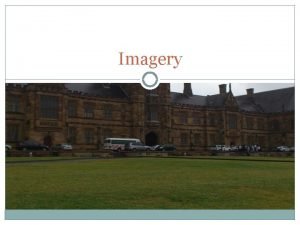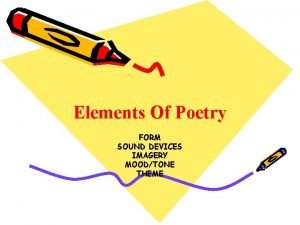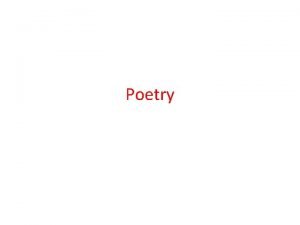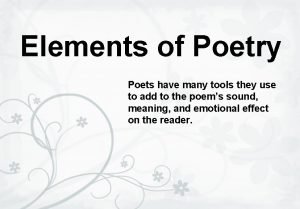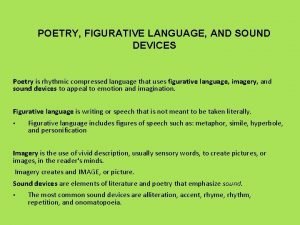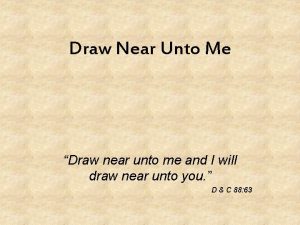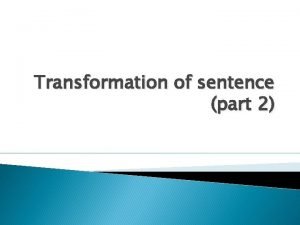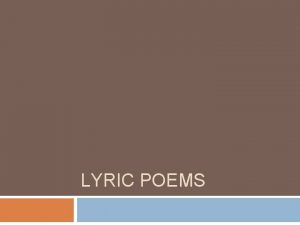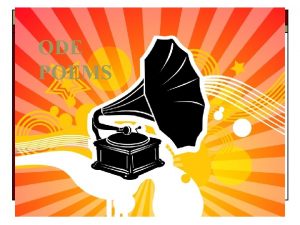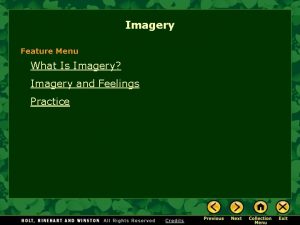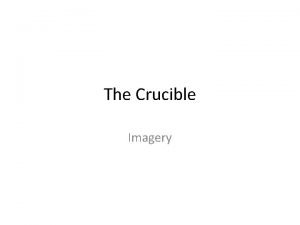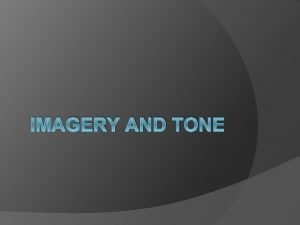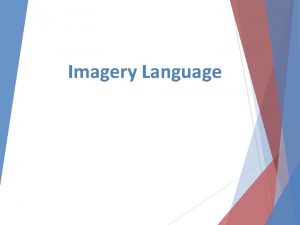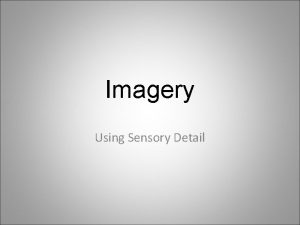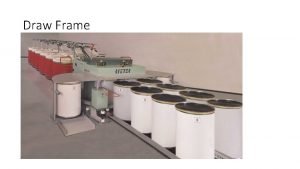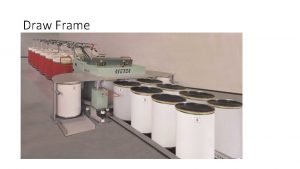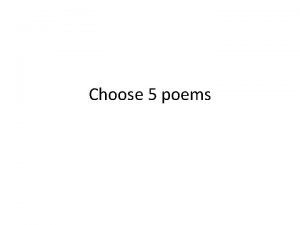Imagery Definition Imagery Poems draw the reader into














- Slides: 14

Imagery

Definition Imagery Poems draw the reader into poetic experiences by touching on the images and senses which the reader already knows. The use of images in this type of poetry serves to intensify the impact of the work.

Image? Images are essentially word-pictures and they usually work by a method of association. This means that the images are created by associations that we make as readers within the linguistic context of the text. For example, the word "red" immediately creates an image or picture of the color red in our minds. This color is associated or has connotations with other feelings or images, like anger, and this increases the depth of the poem.

Imagery in Poetry Imagery refers to the "pictures" which we perceive with our mind's eyes, ears, nose, tongue, skin, and through which we experience the "duplicate world" created by poetic language. Imagery evokes the meaning and truth of human experiences not in abstract terms, as in philosophy, but in more perceptible and tangible forms.

Imagery Experience comes to us largely through the sense. Example: A poet seeking to express the experience of spring day, must therefore provide a selection of sense impressions. So the poet’s language must e more sensuous than ordinary language.

Type of Imagery Poetry appeals directly to ours sense: ü to see : visual images ü To hear : auditory imagery ü To smell : olfactory imagery ü To taste : gustatory imagery ü To touch : tactile imagery ü An internal sensation : organic imagery ü A movement/tension : kinesthetic imagery

Why poet use imagery? A good poet does not use imagery -- that is, images in general -- merely to decorate a poem. He does not ask Himself, "How can I dress up my subject so that it will seem fancier than it is? " Rather, he asks himself, "How can I make my subject appear to the reader exactly as it appears to me? "

The function of Imagery? Imagery helps him solve his problem, for it enables him to present his subject as it is: as it looks, smells, tastes, feels and sounds. To the reader imagery is equally important: it provides his imagination with something palpable to seize upon.

Cont…… As Sir Philip Sidney said: "Imaging is itself the very height and life of poetry. " It must be so, form the very nature of poetic vision, which always embodies itself in the form of symbols. The personality of the poet, which is the well-spring of his poetry will be a world created from all that he has known and felt and seen and heard and thought. His image-making poetic faculty and his imagination will blend together his memories and his immediate perceptions into a thousand of varieties of shapes and associations of living loveliness and power.

Cont…. How imagery comes to the poet, how it is carried alive into the heart by passion is too mysterious a process to analyze. It brings us back at once to the problem of creation in general. Under the influence of the creative ferment, the consciousness of the poet seizes association and poetry is the union of the mental and emotional excitement of the experience with imagery which leaps to meet it, and which must be already in the memory of the poet.

Why we have to understanding imagery? Understanding the use of images means understanding the essential meaning of the poem. Think of images as useful "tools" that the poet uses in order to reveal or explain the meaning that is in the poem

Meeting At Night The gray sea and the long black land; And the yellow half moon and large and low; And the startled little waves that leap In fiery ringlets from their sleep, As I gain the cove with pushing prow, And quench its speed i’ the slushy sand

Imagery To build imagery, writer use figurative language to make their writing more imaginative, alive, and powerful. Figurative language such as simile, metaphor, personification, and allusion

Further Reading Read the poem of 1. T. S Eliot : Prelude 2. William Shakespeare : My Mistress’ Eyes
 Imagery writing definition
Imagery writing definition Site:slidetodoc.com
Site:slidetodoc.com Assonance examples
Assonance examples 6 line stanza poem
6 line stanza poem Figure of speech sound devices
Figure of speech sound devices Draw near unto me and i will draw unto you
Draw near unto me and i will draw unto you How to draw use case diagram in draw.io
How to draw use case diagram in draw.io Example of assertive sentence
Example of assertive sentence Hình ảnh bộ gõ cơ thể búng tay
Hình ảnh bộ gõ cơ thể búng tay Ng-html
Ng-html Bổ thể
Bổ thể Tỉ lệ cơ thể trẻ em
Tỉ lệ cơ thể trẻ em Chó sói
Chó sói Tư thế worm breton là gì
Tư thế worm breton là gì Bài hát chúa yêu trần thế alleluia
Bài hát chúa yêu trần thế alleluia
